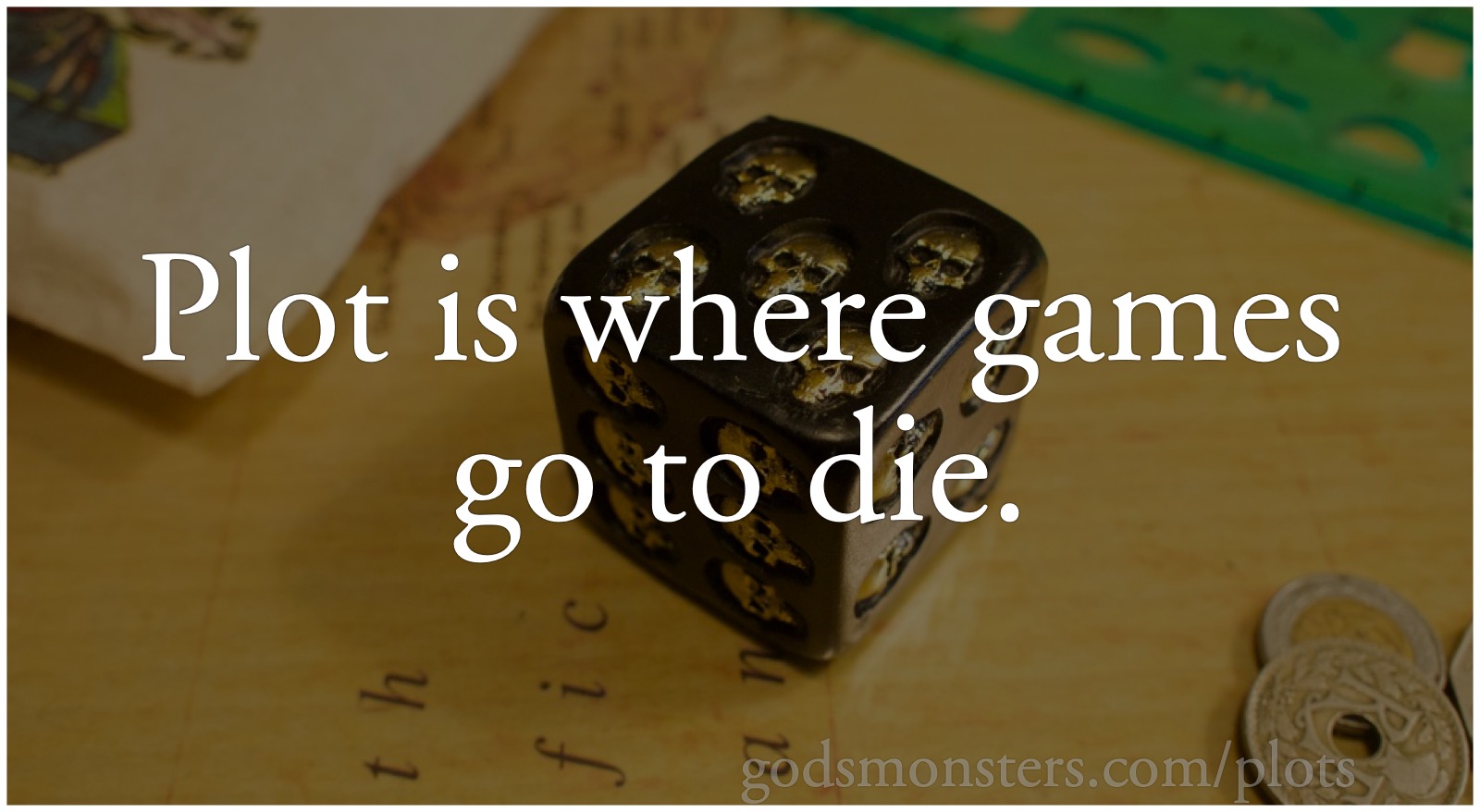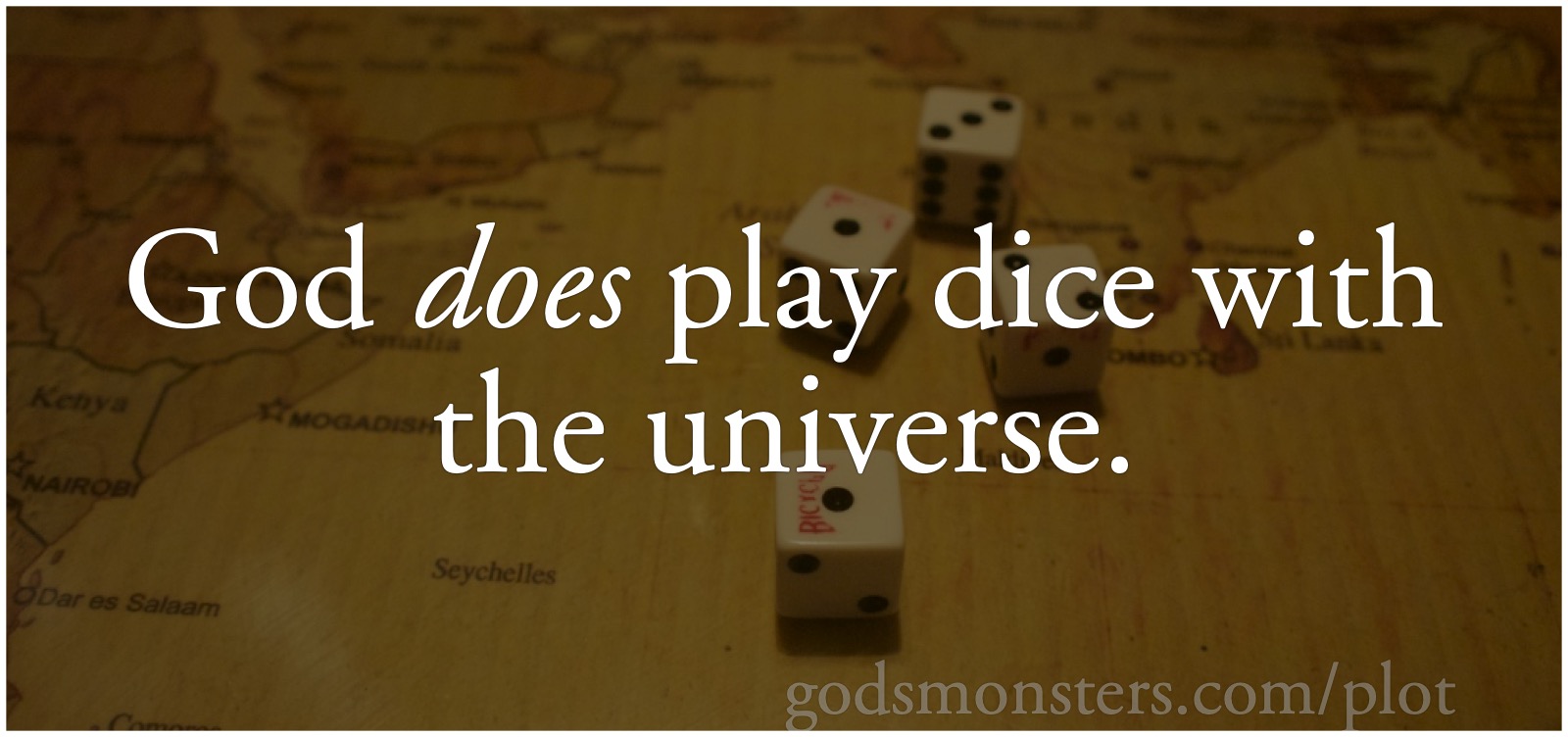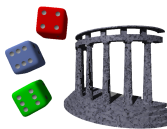The Adventures of Heisenberg’s Cat

The player characters arrive at the crossroads of dead Rome beyond the Vale of the Azure Sun. Behind one of the doors is the land of Barcelas. A tyrant is rising to crush the land beneath his spider minions. His armies are at the gates of Hamokera. If the player characters enter this land, they will turn the tide against this villain. If the player characters don’t enter the land… what? the tyrant takes over? Who cares? No one ever saw, no one will see it. If they arrive at Hamokera later, the plot’s not going to be “a tyrant attempts to take over the world”. It will be “the player characters try to overthrow the evil tyrant”, or “the player characters try to evade the evil tyrant as they continue their mission”, or whatever the player characters try to do.
The plot is what the characters see and interact with, and no more. If you start making the plot be what you know rather than what they do, you’re writing a novel. You don’t need the players for that. Plot is a word used to describe stories and narratives. If the players don’t get caught up on them, they’re not plot points.
So if they ignore the massing army and go west to find their fortune, does that mean the army takes over their hometown? Sure, why not? But that’s not part of the plot. The plot doesn’t start until the player characters decide to do something about it, to take notice in some way. If they do decide to get involved later, then the plot would be something like “hometown sons do well abroad, return to save hometown”.
You can argue about whether plot is more important than character in fiction; but there is no argument in a game such as Gods & Monsters that has definite player characters. In a novel, the author makes the plot. In Gods & Monsters, player characters are the narrative, and the plot is whatever they follow.
To the extent that games like these have plots, the plot doesn’t start until the players are involved. Everything before that is just backstory. Not even backstory, just potential backstory—like the cat whose death Schrödinger tried to pin on Heisenberg, it’s neither there nor not there until the player characters take an interest.
- February 16, 2022: Plots are for the dead
-

In Plot is the opposite of roleplaying, I wrote that “no one, not even the GM (especially not the GM), knows what the plot will be, because any plot relies on player interaction.”
Especially not the GM because plot must be directed action, by or upon some observer. This is true even in fiction, where some things the author knows must have happened are not plot until they are written for the reader. Sure, the walk-on character probably slept within the last twenty four hours. But that’s not part of the plot until it has some effect. Likewise, the plot of Mountains of Madness is not boy meets girl despite Lovecraft knowing that boys and girls were meeting all over the world while Dyer and Danforth were exploring the subterranean ruins.
That’s despite all the efforts of Hollywood to require a boy-meets-girl subplot in any such movie. The fact is, much of what I dislike about tying roleplaying to movies isn’t even true of movies. From Richard Linklater’s Dazed and Confused (or Waking Life) to The Breakfast Club to Napoleon Dynamite or Lost in Translation, movies can be great without a traditional plot. An arbitrary beginning, a middle that is about the characters, and an arbitrary ending that doesn’t really tie anything together can be a great movie. A typical D&D game is in the middle of those extremes.
I dislike comparing roleplaying to novels and movies because too often this means dumbing down the roleplaying to ensure specific outcomes. But our understanding of “plot” comes from those sources, so it’s worth looking at them. The most basic requirement for being plot in non-roleplaying formats is that plot must be presented, directly or indirectly, for the reader to read it or the viewer to view it. There can be more restrictive definitions of plot, but less restrictive ones are a hot mountain of madness.
Saying that there are plots in the game that don’t involve the PCs is like saying that there are plots in the novel that readers never see, or plots in the movie that viewers never see. If an NPC’s plot never comes near the PCs’ plot, how do the players discover it? How does it matter to them? If the only player that knows about it is the GM, how can it be part of the narrative? How can it be involved in the roleplaying of a roleplaying game?
It may be true that there’s a character who never shows up in the book who is hunting a murderer who also never shows up in the book. But if the author is the only person who knows that’s going on, it’s not part of the plot. It’s not part of the book or the movie.
- January 19, 2022: Plot is the opposite of roleplaying
-

In Burning Wheel, Luke Crane writes that “…nothing happens in the game world that doesn’t involve a player character.” But if NPCs aren’t proactively running their own storylines even when the player characters aren’t involved, doesn’t this mean the NPCs are static?
For example, the orcs are defeated and the player characters leave the frontier village that had been threatened by them. Do the villagers stop everything once the player characters leave? Or do they continue with their lives, long after the PCs have gone, making their own stories and living their own plot lines?
That’s the kind of question that always comes up when someone says something like what Luke Crane wrote. But I’d argue that it’s the NPCs running their own storylines that are static. Such NPCs have their actions locked in without regard to the player characters. They are far more static than the cloud of possibilities that they ought to be in a game that is about roleplaying, about the interaction between player characters and each other, and between player characters and the world.
A dynamic NPC is a cloud of potential narratives waiting to coalesce once they interact with an observer, and the only true observer in a roleplaying game is a player. Non-player characters are not lesser player characters. They are part of the world that the players interact with through their characters.
Of course the villagers would continue their lives, and would do so long after the PCs have gone. But what this means, what they do, only matters once those villagers’ lives involve the PCs again. Nothing happens—there is no plot—that doesn’t involve player characters.
Sandboxing is sometimes described as “plot everywhere”, but that assumes plot must exist. In a sandbox, there is no plot to find. Any narrative must be created by player interaction with the world. Players expecting to find rather than create a plot will be frustrated by sandbox play, as the common complaint about having to “hunt for plot” indicates. Hunting for something that doesn’t exist will always be frustrating.
It occurs to me that much of the misunderstanding might come from an assumption of the GM as a god who knows all, and therefore knows what the NPCs are doing, which implies that what they are doing is always known. If I say that the NPCs are of unknown potential, then, clearly they must be static. God is no longer paying attention to them! But the GM is not god. In a roleplaying game, god is merely one of the GM’s NPCs. The GM does not know everything, and attempting to pretend they do, by treating unobserved and non-affecting ideas as if they were part of the plot, is a failure mode.
- March 12, 2011: Spilling sand in the sandbox: tying up loose ends
-
“Bwian” commented on The Adventures of Heisenberg’s Cat:
The PCs are the centre of the universe! Yay!
I agree with this very strongly. The game can’t help being what the participants together make it. This includes the players—therefore their characters actions are key—as well as the GM—whose input is also key, in a different way. The whole enterprise works better if the GM responds to what the players have their characters do. But also in reverse—it helps if the players take account of what the GM just introduced when deciding what their characters do.
The other side of this is that if what the GM is trying to do is make the world seem ‘world like’ to the players, then using 1) ‘secret plans’ (or introducing pre-planned situations, if you prefer) can be helpful sometimes; and 2) as you so remarked, the situation when the players return to the city better be different than it was when they left. This tends to introduce a need for the GM to silently ‘keep track’ of what is ‘happening’ off-screen. That can be at a small scale (what are the orcs in the other rooms doing while the PCs batter down the door), or on a large scale (so what happened to that city, after the PCs left?).
As a GM I often end up with a lot of loose-ends dangling that require a lot of work (or brain-space) on my part to maintain consistency. Any ideas about how to make this less work to handle, while building/ unfolding a sand-box style environment?
First, I really don’t “silently keep track of what is happening off-screen” once the characters leave the area. What “the area” is will depend on what the adventure was, but if it’s not going to affect them, they’re out of the area. At that point, I don’t bother with what’s happening in that area. I tried to find a picture of Harold and the Purple Crayon for the article, because that’s pretty much the way I treat the game: it follows the player characters.
I really did mean it when I said “the plot doesn’t start until the players are involved” and “everything before that is just… potential backstory.” Of course I do keep notes when something occurs to me about a place they might go, or if something interesting occurs to me about a place they’ve already been. But that’s all they are until the player characters actually go there—scattered notes.
I also write a short summary after each session. If the players return to an area, I go back over these summaries and extrapolate what’s happened since. And if I need to introduce something new later, I’ll do a search for something similar in their previous adventures. This allows me to tie in any old incidents they’ve forgotten about with new incidents they’re meeting—i.e., potentially tie up loose threads.
This way, when they suddenly take an interest in the world tree, the adventure will include the druid they just met two adventures ago. Their current adventure didn’t originally include her, and she was just a throwaway character in the old adventure. But now they’re biting on the world tree myths they’ve been hearing? No problem, I’ll pull in the fatherless young druid they rescued earlier.
- Engines of Our Ingenuity: Schrödinger’s Cat: John H. Lienhard
- “Today, Schrödinger’s Cat changes our view of science. The University of Houston’s College of Engineering presents this series about the machines that make our civilization run, and the people whose ingenuity created them.”
- How do I help my players not get caught up on smaller plot points?
- “Not sure how best to phrase the title (edits welcome). I just finished having a conversation with one of my players, and was led to a question I'm not sure I know how to answer.”
- Plot (narrative)
- “Plot is a literary term for the events a story comprises, particularly as they relate to one another in a pattern, a sequence, through cause and effect, or by coincidence.”
- The Vale of the Azure Sun
- There are things in this world that defy all logic. Places that no door enters and no road goes, where the maps exist only in the minds of madmen.
More storytelling
- Cinematic roleplaying is an oxymoron
- Cinematic roleplaying always seems to be about reducing player choice. This is a direct result of trying to emulate an entertainment style that by necessity must elevate the director’s choice above character development. Even the best movies require the director to curtail the world in which the action and dialogue takes place.
- Say yes or use the magic 8-ball
- Is “Say yes or roll the dice” something that works in Gods & Monsters? Outlook not so good.
- Spilling sand in the sandbox: tying up loose ends
- How do you maintain consistency in a “plot” that is not under your control?
- We are walking narratives
- Some quick notes about my “gaming is not storytelling” article before I forget about them.

Update: an anonymous commenter wrote:
I note this because (a) I enjoy the term “half-quibbled”, and (b) I had not yet clarified the indeterminate nature of the cat’s ownership in the final paragraph when they wrote that.